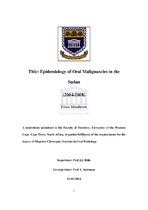| dc.description.abstract | Background: Reports on the global incidence of oral neoplasms indicate reduced data from Africa. Population based studies of oral cancer in Sudan and other regions of Africa are scarce. Oral cancer in Sudan constitutes a serious health problem, and squamous cell carcinoma (SCC) is the most prevalent type of oral malignancy. There are descriptive epidemiologic studies from Sudan that have reported high a frequency rate of oral cancer in Sudanese males, linking this high incidence to Toombak, a product of oral snuff mixed with sodium bicarbonate (Idris et al, 1995(b)), but to date no population-based studies of oral cancer incidence in Sudan have been performed or published. Title: Epidemiology of Oral Malignancy in Sudan (2004-2008). Aims and Objectives: The objectives of the study were to analyse the pattern of distribution and to determine the minimum age standardized incidence rates (ASIR) and the cumulative (lifetime) risk (CR) of oral & lip squamous cell carcinoma / oral malignancy by site, age and gender for the 5-year period 2004-2008. Methods: The records of patients with oral & maxillofacial and salivary malignancies (OMFS) referred to Khartoum Dental Teaching Hospital (KDTH) and the population census data were accessioned. Data was captured using Microsoft Excel 2007® and the ASIRs for oral squamous cell carcinoma (OSCC) were calculated using the direct International Agency for Research on Cancer (IARC) method. These results were compared with the on-line global cancer statistics database (GLOBOCAN -WHO/IARC) for 2008 and 2012. Records of oral cancer cases during the period of the study were obtained from KDTH. The information included in the raw data collected were the file number for patient identification, year of diagnosis, age, sex, site of the lesion, histological diagnosis, the International Classification of Diseases-10 (ICD10) codes, the referring unit and the state from which the patient was referred. The population data for the years of the study and the five age group stratifications was obtained from the Central Statistical Office in Khartoum, Sudan. The data was analysed using Microsoft Excel, 2007®. Age standardized incidence rate of oral & lip squamous cell carcinoma/ oral malignancy was calculated using the direct IARC method. Results: Of the total Sudanese population of 36.3 million in 2006, 649 OMFS malignancies (M:F=1.44:1) were captured at KDTH during the 5-year period; 390 (M:F=1.67:1) were (intra) oral squamous cancers (OSCC) and verrucous carcinomas (VC). The ASIR for OSCC/VC in Sudan was calculated as 3.19 for males and 1.83 for females (M:F=1.74:1), however the pooled ASIR in the Khartoum and Gezira States was 30% higher for males (4.21) and 14% higher for females (2.09, M:F=2.01:1).The incidence over the 5 years of separately recorded lip SCC/VC in Sudanese males was 26 and 8 for females (M:F=3.25:1).The ASIRs of combined oral & lip SCC/VC in Sudanese males was 3.45 and 1.88 for females (M:F=1.84:1). These compare relatively well with the GLOBOCAN data which estimates a slightly lower ASIR of 3.3 for males and somewhat higher ASIR of 2.1 for females (M:F=1.57:1). The cumulative (lifetime) risk (CR 0-74) of developing oral and lip cancer was 1: 182 for males compared to 1: 831 for females. For oral cancer (excluding lip), the CR was almost similar for males (1: 181); while females showed a markedly higher CR (1: 344). Conclusion: The combined ASIRs of oral & lip SCC/VC from the Khartoum and Gezira states differed from the ASIRs calculated for the entire Sudan and from the GLOBOCAN estimates. The recording of cancer incidence data can vary according to the (incorrect) labelling of anatomical locations and diagnosis. The numbers are influenced by geo-political, environmental and socio-economic factors, and referral bias. | en_US |

